Easy Same Day Small Batch Focaccia
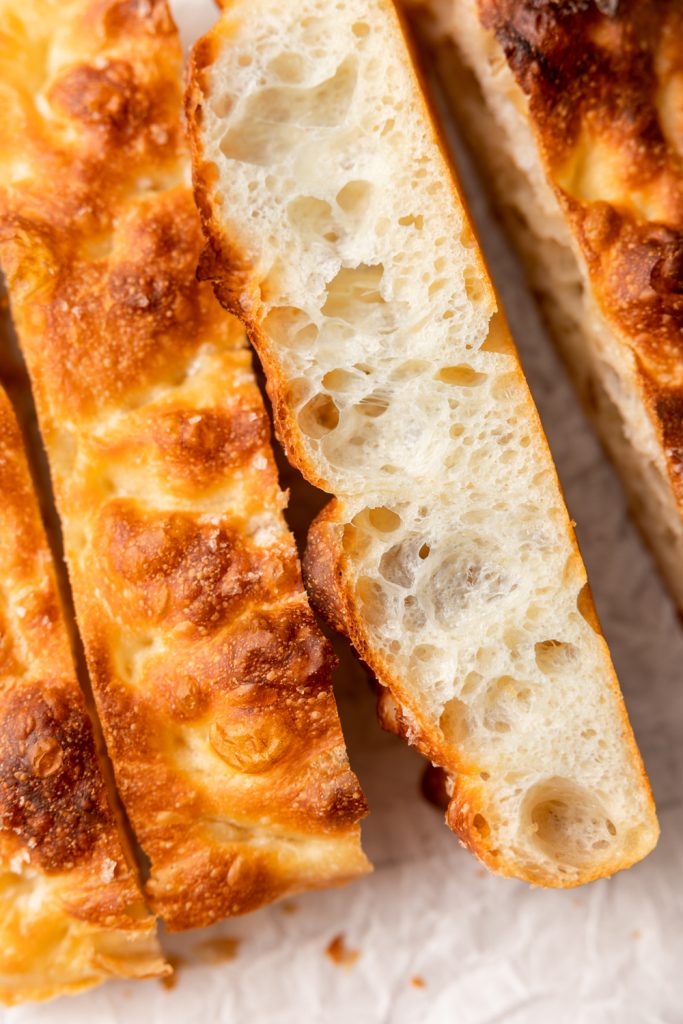
What is a small batch focaccia? Lots of typical focaccia recipes are cooked in large sheet pans and yield a huge slab of bread. This recipe is designed to be much smaller, perfect for 2-4 people. If you don’t eat tons of bread (who are you? lol), or don’t want leftovers, this is perfect for you.
Focaccia is an Italian flatbread, and it is so delicious. There are many types of focaccia in Italy, however the most popular kind in the US is a Ligurian or Genovese style. It’s fluffy and easily adaptable with spices and herbs, and additionally it can be quite simple to make. It doesn’t require a lot (or any) kneading, just time. My traditional Overnight focaccia is a scaled up version of this small batch focaccia, but if you’ve ever made it you know it makes quite a bit of bread. This recipe is designed to be made same day, and is best for 2-3 people or really can be a personal pan of focaccia if you put your heart into it.
If you have never had focaccia or baked bread, this is a great recipe to start with. Focaccia is pillowy soft and just a really great flavor even without the addition of any herbs or spices. I personally love to use olive oil infused with herbs while dimpling the dough. Because the olive oil is a prominent flavor, I always recommend using a good one for it. It will definitely enhance the flavors and be worth the cost.
My overnight focaccia is truly a no-knead bread, you let it cold proof for about 18 hours to develop the gluten and flavor. Because this small batch focaccia is designed to be made the same day in just a few hours there is a little bit of “kneading”. However, we aren’t doing any traditional kneading, but lightly stretching and folding the dough while it proofs. Don’t be intimidated, I guarantee you can do it!
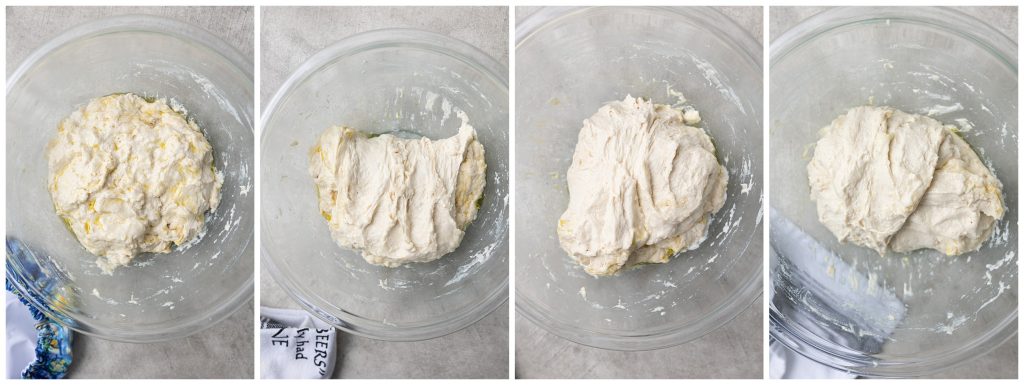
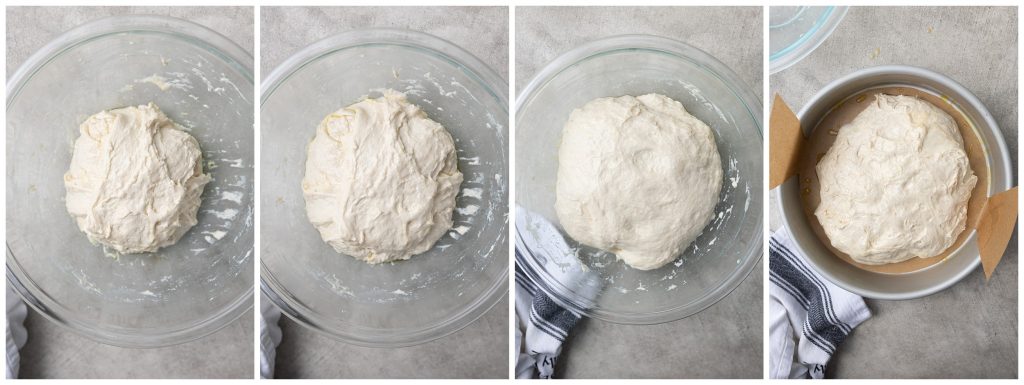
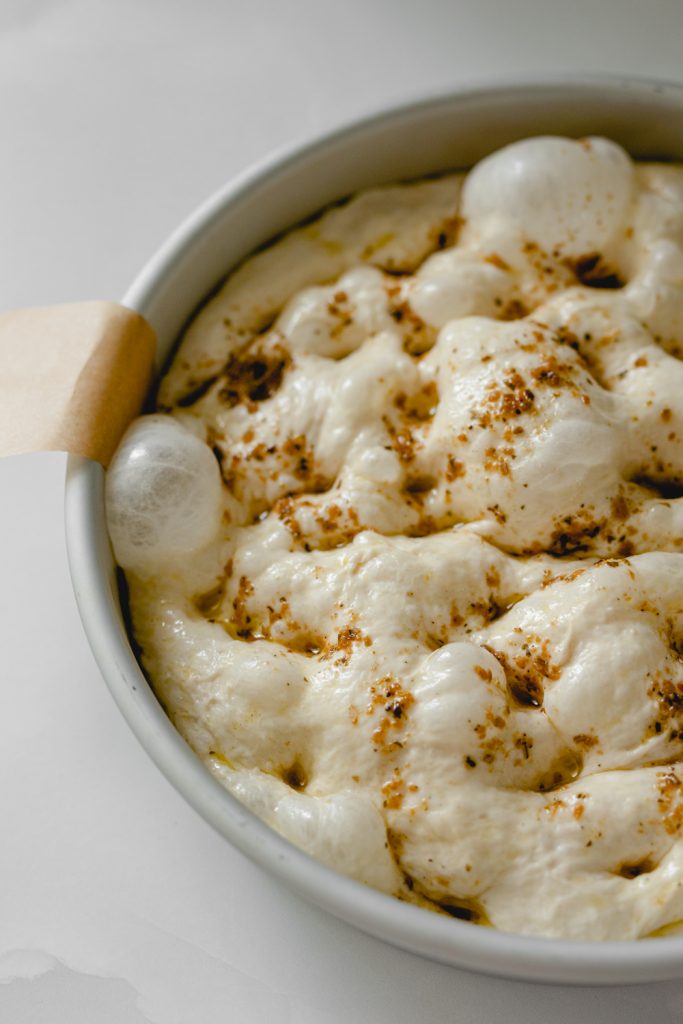

Baking Tips & Notes
I typically make this small batch focaccia in an 9″ round metal cake pan (I like these ones) and the bread is nice and thick. You could use a quarter sheet pan, or an 8 or 9″ square pan if you’d like the bread to be just a little thinner. I always urge using a metal pan, not glass. Metal will cook your bread more evenly and quicker, and help develop the crust better.
It’s going to feel like a lot of olive oil, but olive oil is essential for both the crust and it will help prevent your bread from sticking to the pan. You can also use parchment, which if you do, parchment first, then olive oil.
When adding water to your dough, make sure it is not too hot. Above about 120F will kill off the yeast and your bread will not rise. Cold water will work but your proofing times will be extended. A thermometer and a temperature of about 105 is what I aim for.
Focaccia is better when it is baked to a good color. This helps develop the crisp exterior of the bread (top, bottom and edges), as well as preventing the bread from becoming soggy. When it’s ready it will have a deep golden brown, and any large air bubbles may be slightly blackened. You don’t want to burn the bread but you definitely don’t want to bake until just lightly golden.
Additionally, don’t cut into the bread too soon as this can make the texture of the bread a little undesirable as not all the steam as been released from the interior and the starch molecules are still waterlogged . Bread that is immediately cut into often will have a gummy texture. Don’t let all your hard work be wasted by not being able to wait just a little bit longer.
If you’re looking for other focaccia variations, here are some of my faves:
- Pesto Caprese Focaccia
- Cheesy Skillet Focaccia
- Pizza Focaccia
- Sweet Orange Focaccia
- Cinnamon Apple Focaccia
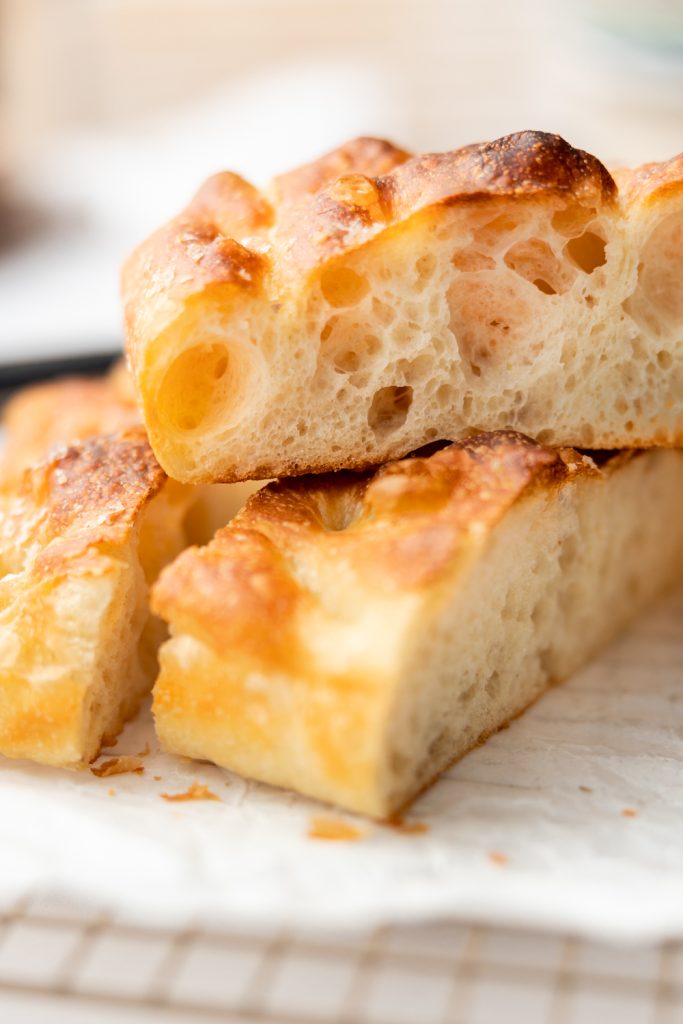
Small Batch Focaccia Key Ingredients
- Bread Flour – Can you use all purpose? Yes, but would I suggest it? No. Bread flour has more protein and therefore can create a stronger gluten network. Your bread can be airier and chewier.
- Olive Oil – If you’ve made focaccia you know don’t skimp on the olive oil. It’s going to seem like a lot, even too much, but that’s how you know its right and going to taste fantastic. It also helps with the crust on the bread.
- Salt – This small batch focaccia recipe is a great base as it’s sort of like a “plain” version that can easily be added to. You can definitely add herbs and additional spices but trust me when I say, with simply salt and olive oil your and taste buds will be singing.
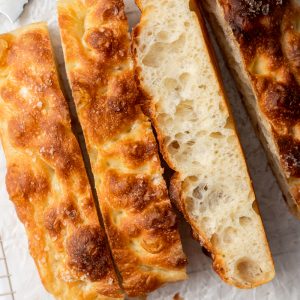
Ingredients
- 280 g Bread flour 2¼ cup
- ½ tbsp Morton kosher salt or fine sea salt
- 1 tsp Instant yeast
- 1 tsp Granulated sugar
- 265 g Water ~1 cup + 2 tbsp, warm (~105°F)
- 3 tbsp Olive oil divided
- 3-4 tbsp Olive oil for dimpling the dough
Instructions
- In a medium-large bowl, combine your flour, kosher salt, yeast, sugar, water, and 1 tbsp of olive oil. Mix until combined into a wet shaggy dough.
- Pour an additional tablespoon of olive oil over the dough, and smooth over and turn the dough in the bowl, coating it in oil. Cover and let rest for 30 minutes.
- After 30 minutes, uncover your bowl and push your fingers underneath the top edge of the dough at the 12 o'clock position. Pull the dough up towards you, stretching it and fold it in towards the center/opposite side of the bowl.
- Turn your bowl a quarter turn, and repeat. Do this an additional two times until you have stretched and folded all sides of the dough in, for a total of four folds.
- Recover your dough and allow to rest for another 30 minutes.
- Repeat your stretch and fold process (four more folds), and then recover your bowl and let rest for 30 more minutes. You should notice a little more tension in the dough than the first set of folds.
- If your dough is in a warm spot, after this, your dough should be puffy and bubbly, roughly having doubled in size. If it has not grown in size allow to continue proofing until it has done so.
- Using either a 9×9" square cake pan or a 8" round cake pan, pour 1 tbsp of olive oil into the bottom of the pan and grease your pan, making sure to get the corners and sides.
- When your dough is ready, dump into your prepared pan, as well as any leftover oil from the bowl. Cover your dough and allow to proof for an additional 30 minutes.
- While your dough is in its final proof, preheat your oven to 425°F.
- After 30 minutes, drizzle with additional olive oil and dimple your dough, sprinkle with flaky sea salt and place on the center rack of your oven to bake.
- Bake for about 22-25 minutes or until your dough is medium golden brown. Remove from oven and onto a cooling rack. Allow to cool for at least 30 minutes before cutting into it.
- Bread can be kept in an airtight container for about 3 days but is best enjoyed on the day it is baked. Enjoy!

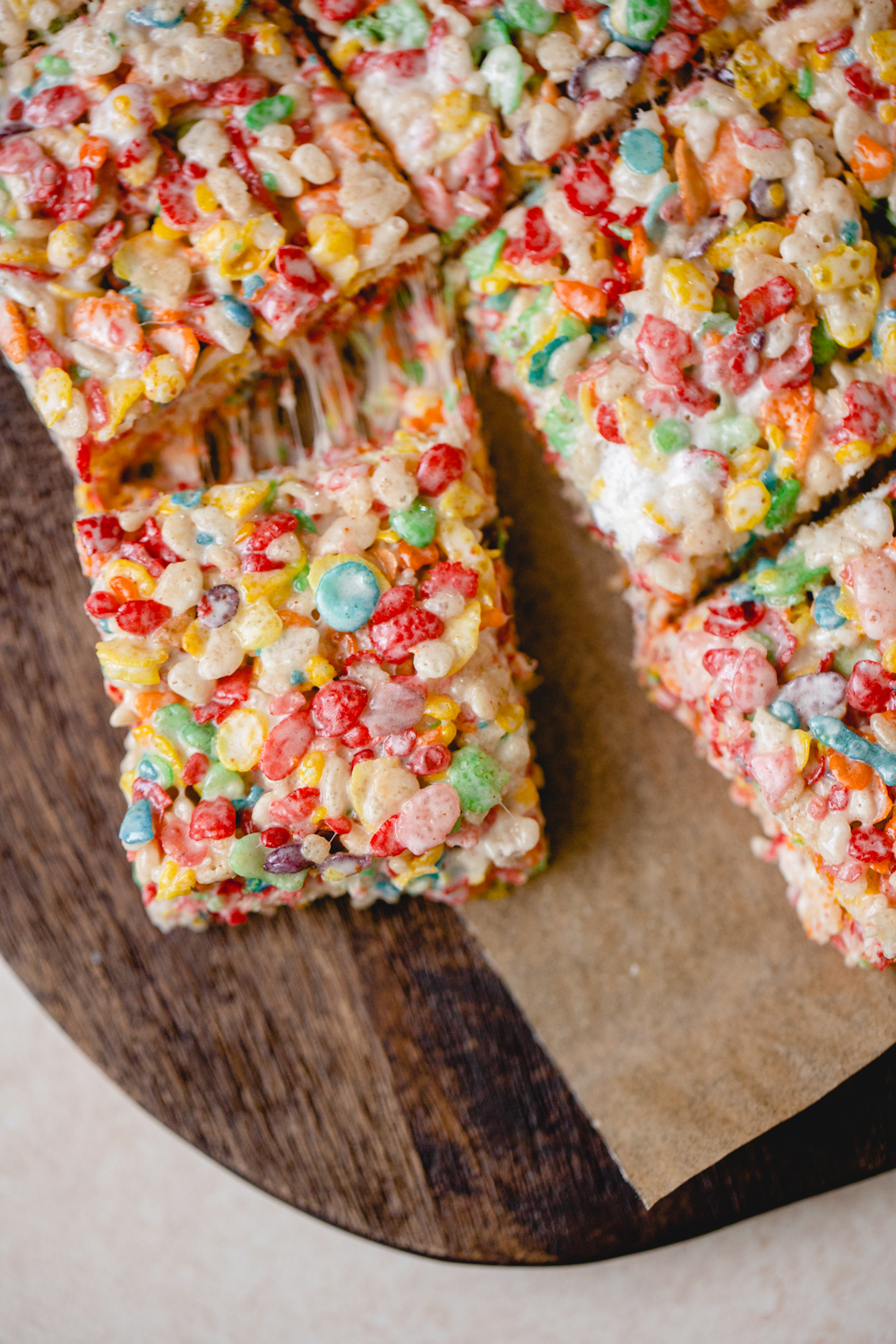
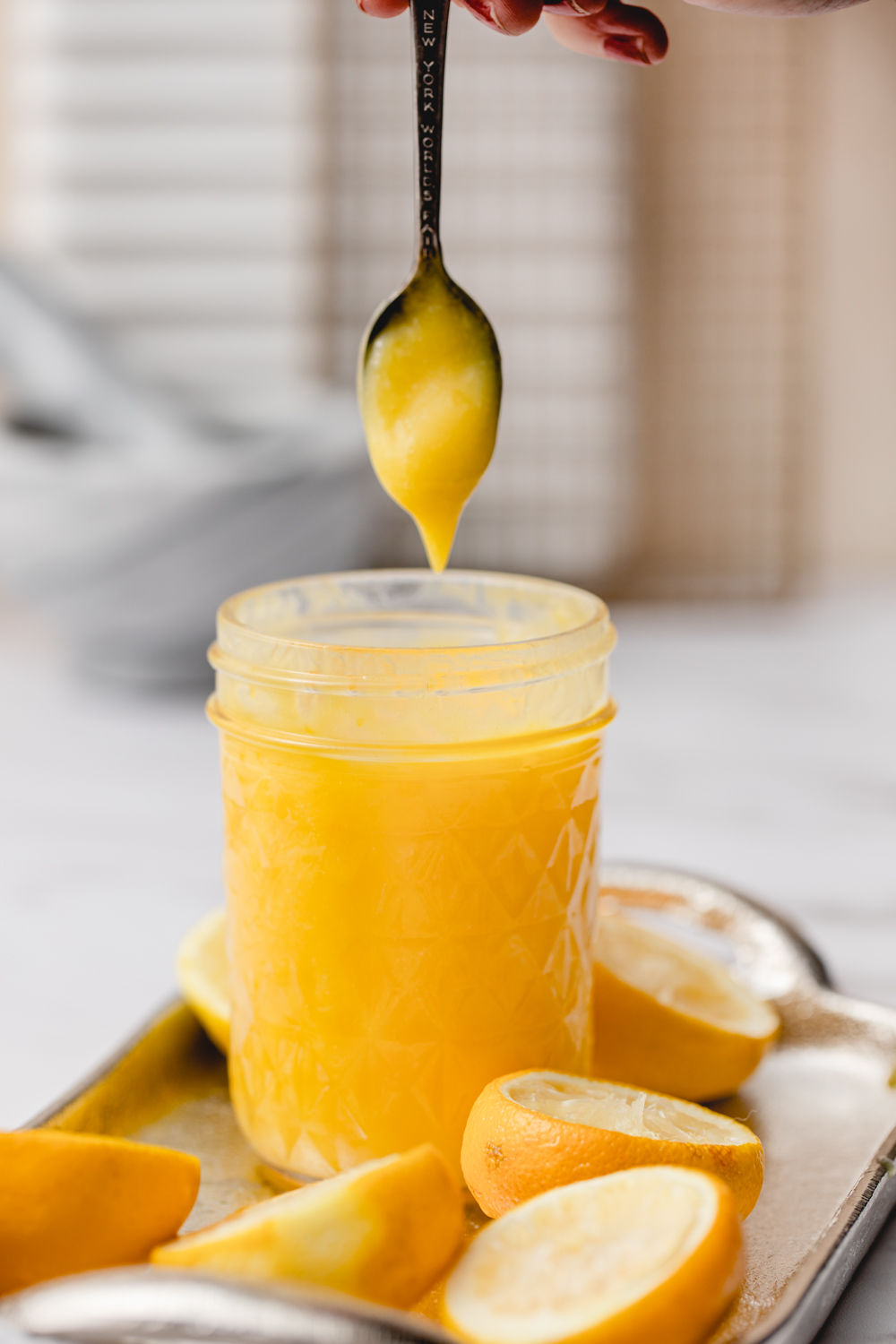
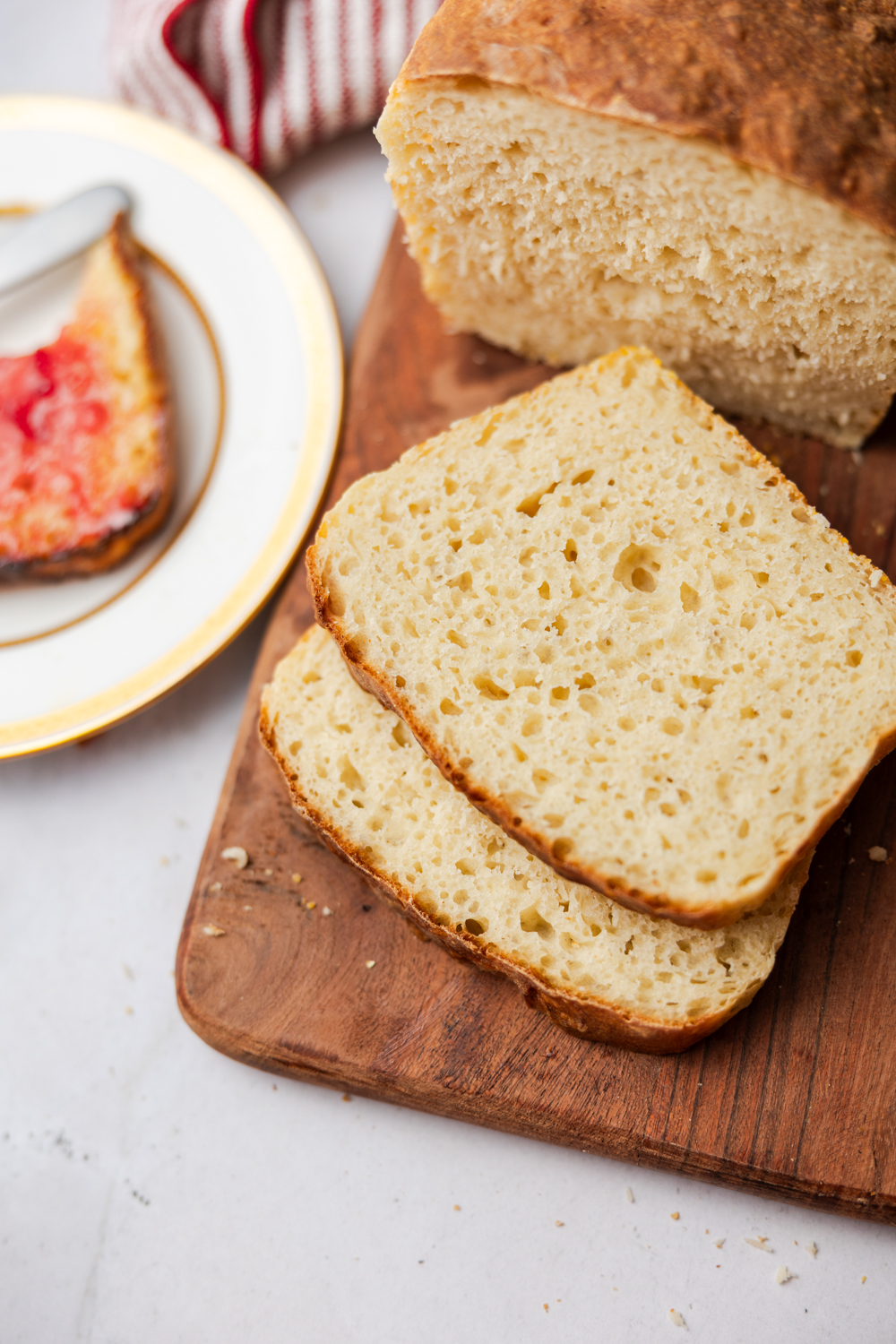
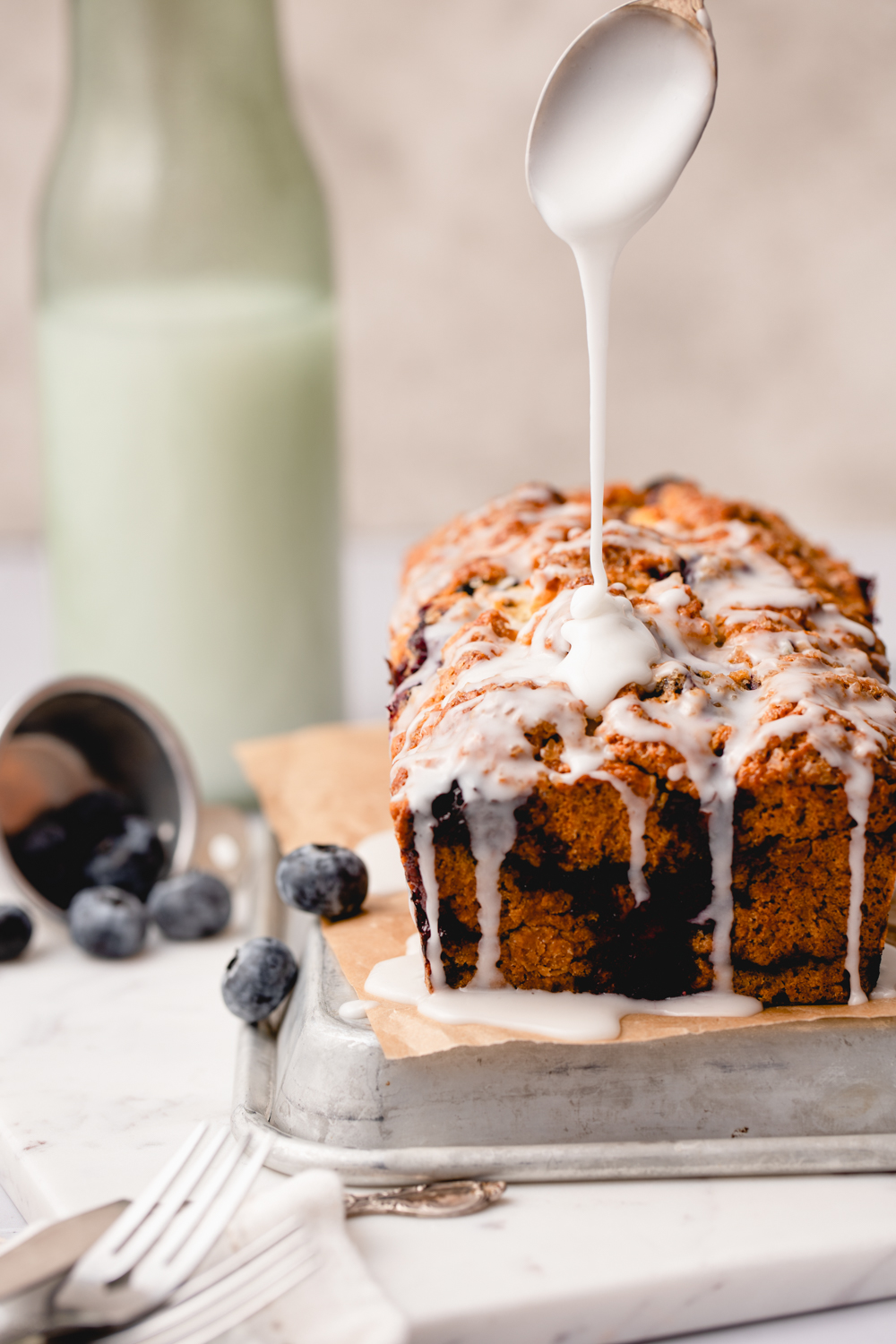
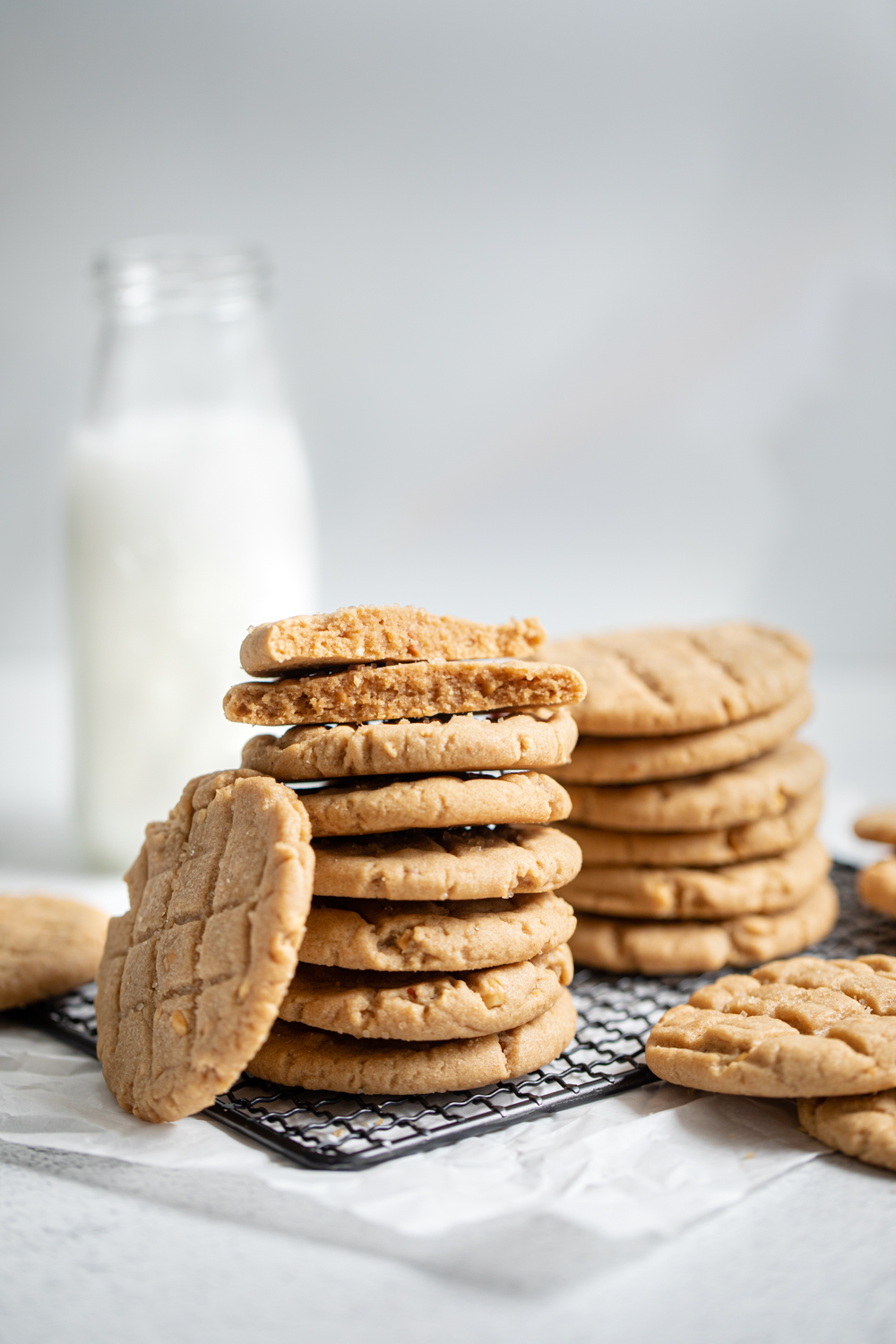
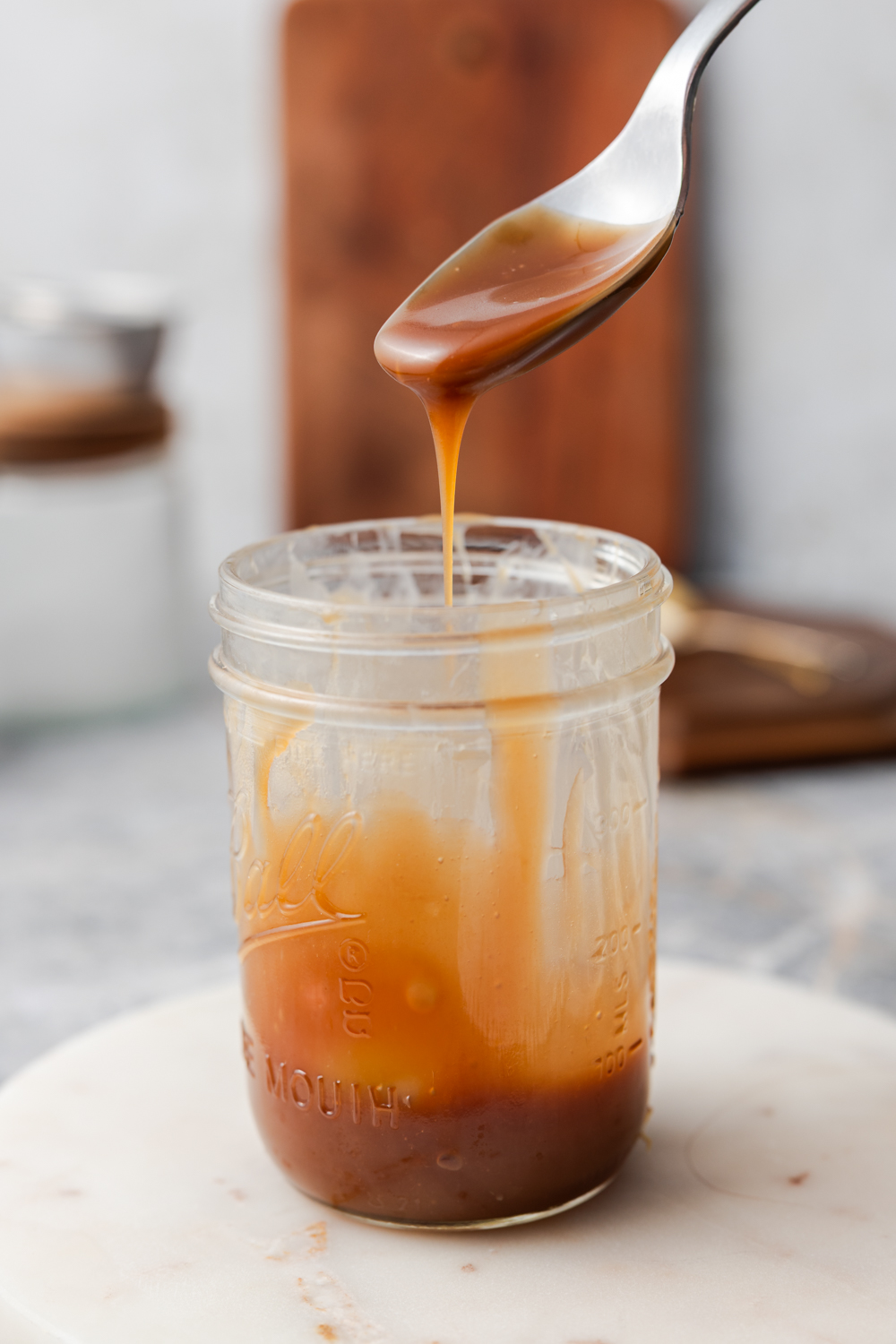
I ate the whole thing, so delicious ?
Haha, maybe I should add single serving to the title? But truly, I’m so glad you loved it!
Sorry, but this is a piece of garbage. And I know how to bake bread. It is gummy, it stuck solid to the pan, it barely had bubbles.
Dry. This a definite non repeat and I feel sorry for anyone that tries this as their first try, fails and then never tries again.
Hi Anna,
I’m sorry to hear this recipe didn’t work out for you. This one is staple in our home, and one of the more popular ones on my site. I’m not exactly sure how it was both gummy and dry, as those tend to be in opposition to each other. Gummy can result from using AP instead of bread flour (this is more rare), underproofing, too much water (over hydrating) or often, under-baking the bread and/or cutting into the bread too quickly. However, dry bread is usually the result of not enough water, or overbaking the bread. With focaccia it could also be not enough olive oil on the exterior would lead to a dry crust that isn’t crispy like it should be. Because it stuck to the pan, it may have been not enough olive oil. Not enough bubbles tells me either under or overproofing the dough, or not enough water (high hydration doughs will have big bubbles and airier crumb). That being said, it’s hard to know what went wrong in a bake without seeing it and being there to have seen the process. I hope you find a recipe that works better for you though.
This is my sixth time making this recipe, and each time I have had beautiful results – delicious taste and excellent texture! Perhaps your severe criticism should be directed inward. Based on the overwhelmingly positive feedback here, the failures you stated must be due to your own errors. It’s okay to express your disappointment, but there’s a mature and kind way to show that. Obviously, you have not learned how to do that yet. And since you “know how to bake bread,” may your future endeavors be more successful.
Hi Marie, thank you so much! I’m so happy this is a recipe you love and make on repeat for your family! 🙂
I’ve been using this every weekend sometimes twice a weekend clearly you’re doing something wrong
I’m so happy this is a repeat bake in your home! Thank you for your support 🙂
I love this recipe. I meant that the person who ends up with it gummy is doing something wrong.
Do you think I could make this in a loaf pan?
That’s a great question. So I haven’t done this myself, but I don’t see why you couldn’t. If you’re wanting to make like a sandwich style loaf it probably won’t be as tall, but thicker than focaccia is normally. If you try, I’d still use parchment and oil but when you dimple I wouldn’t try to go all the way to the bottom, just maybe an inch or so. The bake time might also increase to probably 30-40 minutes? I’d start checking it around 30 minutes and go by internal temperature if you have an instant thermometer. If you try this let me know if it works!
If you just wanted to make an even smaller version, like a loaf pan size, I’d probably half the recipe and then treat it like normal focaccia. Or I do have a Mini Focaccia recipe that makes little personal size ones using baking rings if you truly want mini ones. I hope all of this helps!
Wow that sounds amazing!
I have tried several focaccia recipes and this is the only one that “worked” for me. By “worked,” I mean it was the only dough that proofed and had good rise with air bubbles required to make a good focaccia. One important lesson I learned was to use a thermometer to check the water temperature. What I considered ‘warm’ was actually ‘cool.’ Make sure your water temperature is between 100-115.
Hi Anna, I’m so happy this recipe not only worked for you, but turned out well! This is absolutely true about water temperature! Sometimes it’s surprising how cool water can be that feels warm. While 85 degree water will still work, having it at about 100-105 tends to be the sweet spot!
I used a bit more olive oil infused with rosemary and garlic. Then topped the dough with the sliced garlic pieces and rosemary needles used to infuse the oil before baking. The end result was a perfect pillow soft loaf that was just the right size for family dinner. My new go to recipe!
I’m so glad that you loved it! Those toppings sound soo good with this!
Love it! Been making this for about a year now. Garlic, rosemary and sea salt
Is my fave. It looks so wonderful when it comes out, I often take pictures.
This was easy to make and was the perfect size!!
This makes me happy! Thanks for baking 🙂
I always seem to need to add more flour. Is 95% hydration really right? It’s wonderful once I stiffen up the dough a bit, but it’s always runny like a cake batter as written. Am I just not understanding the texture of focaccia dough?
If it matters, I use Bobs Red Mill Artisan Bread flour.
Hi Robert, first thank you for baking my recipe! The hydration level IS correct, however it definitely shouldn’t be runny! I know whenever I make this the first set of folds the dough is the loosest/stickiest and it does firm up a bit with each set of stretch and folds. That being said, I haven’t ever used Bob’s Red Mill bread flour so I haven’t tested it with that particular flour. I know that’s a great option though and looking at the protein count of it, it seems to be similar to King Arthur which is what I usually test with. It’s not a huge image, but you can sort of see the texture mine is on the first set of stretch and folds in the blog post. I’d be happy to chat with you about what might be happening, I always want bakers to have success with my recipes. Let me know!
Such an easy and approachable recipe! It makes the perfect amount for dinner with our little family. Fluffy, chewy and flavorful. Thanks for sharing, I was searching so long for a good, same day focaccia recipe!
Eva Marie, I’m so happy that this recipe works for your family and that you found it! Thank you so much for making my recipe and leaving feedback! 🙂
Just made this on a whim and it turned out incredible! Thank you for providing the perfect last-minute focaccia recipe.
Kate, thank you so much! I’m so happy you loved it. I have quite a few other versions with toppings and flavors if you like this one! Happy baking 🙂
My first go at foccaccia and this recipe was SO simple and easy to follow! I did everything as listed but when it came to final proof I stuffed it with home made garlic butter mozzarella parmesan mixture and then proofed one last time 30 mins. Preheated oven to 425 and baked 22 mins and came out perfectly crispy and light airy bubble and full of flavor from my garlic butter concoction (1/2 cup butter, 6-7 teaspoons garlic, 3 tablespoons parmesan and 1/2 cup of mozzarella)
Darion, your additions sound FANTASTIC and I have to say you’d never know you weren’t a focaccia pro with those toppings. I also have a caprese focaccia, a pizza focaccia and a roasted garlic one – all of those sound like they might be up your alley! Thank you so much for baking and sharing your results!